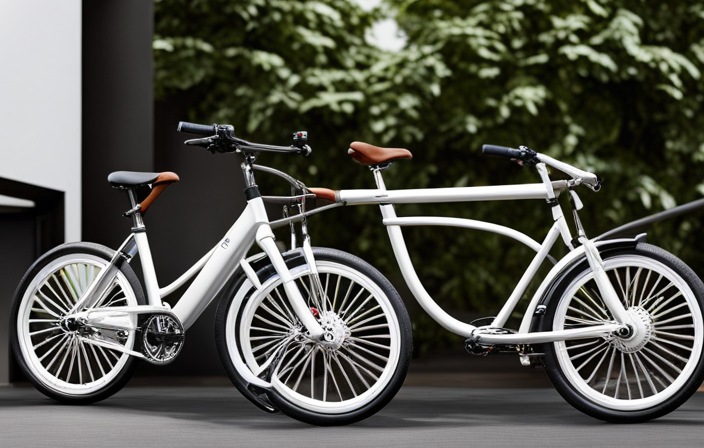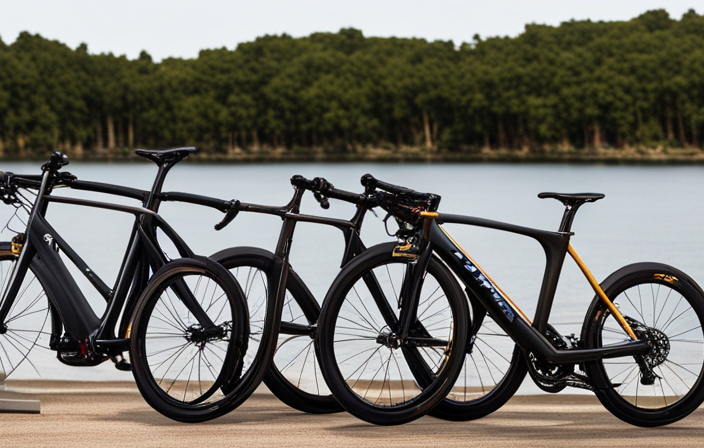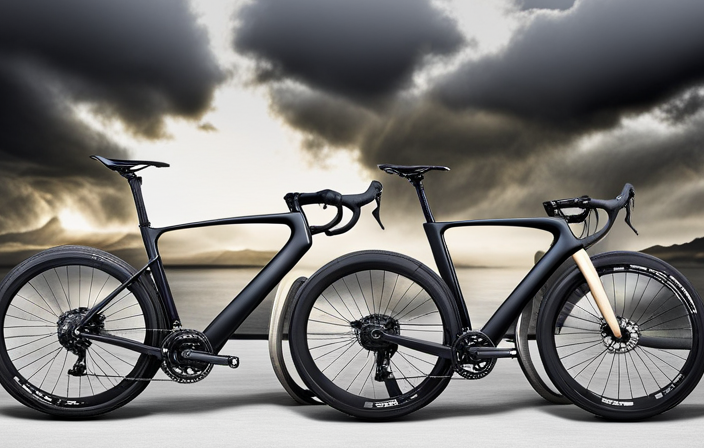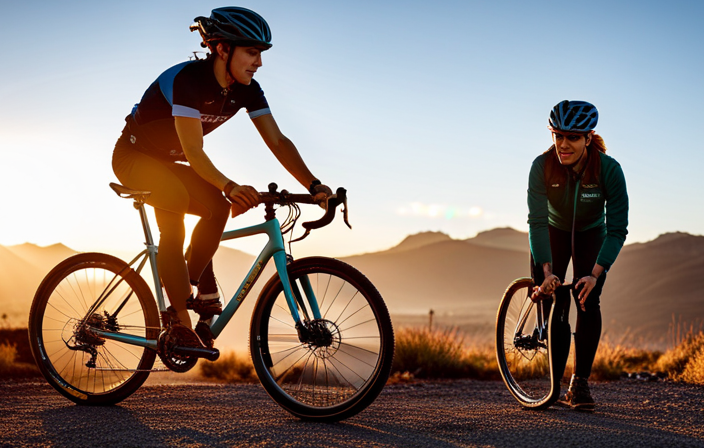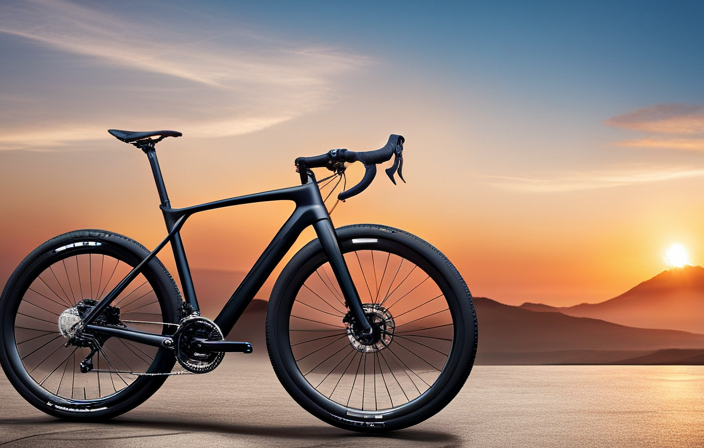While biking through the busy city streets and exploring off-road gravel trails, I come to understand that finding the ideal bike for urban commuting and gravel biking is like uncovering a key that opens the door to exciting new adventures.
It’s a quest that requires careful consideration of our riding style, frame material, bike size, and type. With comfort and ergonomics in mind, we delve into research, seek expert advice, and ensure a reputable purchase.
Join me on this journey as we navigate the world of bikes built for both concrete jungles and rugged terrains.
Key Takeaways
- Analyze preferred riding style (leisurely city rides or adventurous gravel trails)
- Consider important bike features (lightweight frame, smooth tires for city riding; wider tires, suspension system for gravel)
- Think about specific needs (storage space, comfort)
- Consider frame material (aluminum, carbon fiber, steel, titanium)
Determine Your Riding Style and Needs
Figure out what kind of riding you’ll be doing and what your specific needs are. This is the first step in choosing the right bike for city and gravel riding. Start by analyzing your riding style. Are you someone who enjoys leisurely rides along smooth city streets? Or do you prefer more adventurous off-road excursions on gravel trails? Understanding your preferred riding style will help narrow down the type of bike that suits you best.
Next, consider the bike features that are important to you. If you plan on mainly riding in the city, a bike with a lightweight frame and smooth tires may be ideal for efficient maneuverability. On the other hand, if gravel paths and rough terrains are your go-to, opt for a bike with wider tires and a suspension system to absorb shocks.
Additionally, think about any specific needs you have. Do you require ample storage space for commuting or grocery runs? Look for bikes with racks or baskets. Are you concerned about comfort during long rides? Consider bikes with adjustable handlebars or padded seats.
Now that we’ve analyzed our riding style and determined our specific needs, let’s move on to considering the frame material when selecting the perfect city and gravel bike.
Consider the Frame Material
When considering the frame material, it’s important to choose one that suits your riding preferences and terrain. There are several options available, each with its own pros and cons.
One popular choice is aluminum, which is lightweight and affordable. It provides a stiff ride that is ideal for city commuting but may not absorb as much vibration on rough gravel roads.
Carbon fiber frames are another option, known for their strength, stiffness, and light weight. They excel at absorbing road vibrations, making them great for longer rides on both city streets and gravel paths. However, carbon fiber frames can be expensive.
Steel frames offer durability and a comfortable ride thanks to their ability to absorb shocks from uneven surfaces. They are heavier than aluminum or carbon fiber but provide a smooth experience on both city streets and gravel trails.
Titanium frames are strong yet lightweight like carbon fiber but offer the added benefit of being more resistant to corrosion.
When choosing a frame material for a city and gravel bike, factors such as weight, comfort, durability, cost, and personal preference should all be considered. The right bike size plays an equally important role in ensuring a comfortable and efficient ride without compromising control or maneuverability through different terrains.
Now let’s move on to selecting the right bike size…
Choose the Right Bike Size
To ensure a comfortable and efficient ride, it’s important to choose the right size for your bicycle. Riding a bike that fits properly will prevent discomfort and potential injuries, while maximizing your pedaling efficiency.
Here are three key factors to consider during the fitting process:
-
Standover Height: This refers to the clearance between your crotch and the top tube of the bike when standing over it with both feet flat on the ground. Aim for at least one inch of clearance to avoid any mishaps while mounting or dismounting.
-
Reach: The reach is the distance from the saddle to the handlebars. It should allow you to comfortably hold onto them without straining your back or shoulders. A proper reach ensures better control and stability while riding.
-
Saddle Height: Adjusting the saddle height is crucial for an optimal riding position. When seated on the bike, your leg should be almost fully extended at its lowest point to generate power efficiently.
By carefully considering these aspects of bike sizing, you can find a bicycle that fits you well and enhances your urban commuting and gravel riding experience.
Now let’s move on to deciding on the type of bike that suits your needs best.
Decide on the Type of Bike
Consider what type of bicycle best suits your needs and preferences. When deciding on the type of bike to buy for city and gravel riding, it is important to determine your budget and choose a suitable bike type. There are several options available, each with its own advantages and disadvantages.
One option is a hybrid bike, which combines features from both road bikes and mountain bikes. These bikes are versatile and can handle a variety of terrains, making them suitable for both city streets and gravel paths. They typically have wider tires for added stability on uneven surfaces.
Another option is a gravel bike specifically designed for off-road adventures. These bikes have wider tires than traditional road bikes, providing better traction on loose surfaces. They also often come equipped with disc brakes for improved stopping power.
If you prefer a more aggressive riding style, you may want to consider a cyclocross bike. These bikes are built for racing in rough conditions but can also handle urban environments well.
When looking for comfort and ergonomics in your bike choice, it’s essential to consider factors such as frame geometry, saddle design, and handlebar shape. By finding the right balance between performance and comfort, you can ensure an enjoyable ride regardless of the terrain or distance.
Transitioning into the next section about ‘look for comfort and ergonomics’, it’s important to consider these aspects when choosing the perfect bike that will provide both comfort and performance on city streets as well as gravel paths without compromising your riding experience.
Look for Comfort and Ergonomics
Finding the right balance between performance and comfort is crucial when choosing a bike for city and gravel riding. One important aspect to consider in terms of comfort and ergonomics is the type of bike handlebars. There are various options available, including flat bars, drop bars, and even ergonomic designs.
Flat bars provide a more upright riding position, which can be comfortable for shorter rides or if you prefer a more relaxed posture. On the other hand, drop bars offer multiple hand positions and are ideal for longer rides as they promote better aerodynamics.
In addition to handlebars, seat comfort plays a significant role in ensuring an enjoyable ride experience. A well-padded saddle with proper width and shape can greatly enhance your overall riding experience by reducing discomfort on longer rides.
It’s important to test out different saddles to find one that suits your body type and preferences best. Some riders may prefer wider seats with additional cushioning while others might opt for narrower saddles providing greater freedom of movement.
By paying attention to both handlebars’ design choices (flat vs.drop) as well as selecting an appropriate saddle based on personal preference, one can find the perfect balance between performance and comfort for their city and gravel riding needs.
Now, as we move on to evaluating the braking system…
Evaluate the Braking System
When evaluating different bikes, it’s important to assess the braking system for optimal safety and control. The durability and performance of the brakes can greatly impact your riding experience, especially in a city and gravel setting. You want a bike that will stop reliably and quickly when needed, whether you’re navigating through busy streets or tackling rough terrain.
To evaluate the durability of the braking system, check for high-quality materials such as stainless steel brake cables and durable brake pads. Look for components that are built to withstand regular use and exposure to various weather conditions. Additionally, consider the overall construction of the brakes to ensure they are sturdy and well-built.
Performance is another crucial aspect to consider when evaluating brakes. Evaluate how responsive they are by testing them out on different surfaces. A good set of brakes should provide consistent stopping power regardless of whether you’re on pavement or gravel.
Transitioning into the subsequent section about checking the gear system, it’s also important to ensure that your bike has a reliable gear mechanism in order to tackle different terrains with ease.
Check the Gear System
When evaluating the gear system of a bike, two key points to consider are the gear range and the shifting mechanism.
The gear range refers to the number of gears available and how they are spaced out, allowing for a wide range of options when it comes to tackling different terrains and inclines.
The shifting mechanism, on the other hand, determines how smoothly and efficiently you can change gears while riding.
Overall, a well-designed gear system can greatly enhance your biking experience by providing optimal performance and versatility on both city streets and gravel trails.
Gear Range
To determine the gear range that is best for your city and gravel bike, you should assess your personal riding preferences and terrain requirements. Here are four factors to consider when evaluating gear range:
-
Gear ratios: Look for a wide range of gear ratios that can accommodate different levels of incline and speed. This will allow you to easily tackle both the hilly urban streets and uneven gravel paths.
-
Low gears: Opt for a bike with low gears that provide enough torque to climb steep hills without exerting excessive effort. This is especially important when navigating off-road terrains.
-
High gears: Consider a bike with high gears that enable you to reach higher speeds on flat surfaces or descents, making your city commutes more efficient.
-
Mid-range gears: Having a good selection of mid-range gears allows for smooth transitions between different terrains, ensuring a comfortable ride.
Considering these factors will help you find the ideal gear range for your city and gravel biking needs.
When it comes to shifting mechanisms…
(Note: Continuing into the subsequent section about ‘shifting mechanism’)
Shifting Mechanism
When it comes to the shifting mechanism on a bike, there are two main options: external gears and internal gears. While external gears are more common, internal gears offer several advantages for city and gravel riding. First, they require less maintenance since the gear components are sealed and protected from dirt and debris. This means you can spend more time riding and less time cleaning or adjusting your gears. Additionally, internal gears provide a smoother shifting experience as they change gears within the hub of the rear wheel, resulting in seamless transitions between gear ratios. Speaking of gear ratios, they play a crucial role in determining how easy or difficult it is to pedal on different terrains. Finding the right gear ratio range allows you to effortlessly tackle both hilly city streets and rough gravel paths. Now that we’ve covered shifting mechanisms and gear ratios, let’s assess the wheel size and tires for your ideal city and gravel bike setup.
Assess the Wheel Size and Tires
The recommended bike for city and gravel riding would have a suitable wheel size and tires. Assessing the wheel size is essential when selecting a bike for these terrains. Smaller wheels, such as 650b or 26 inches, provide increased maneuverability and agility on tight city streets. On the other hand, larger wheels like 700c or 29 inches offer better rolling efficiency and stability on rougher gravel trails.
Choosing the right tires is equally important. For city riding, slick or semi-slick tires with minimal tread patterns are ideal as they provide low rolling resistance and excellent grip on pavement. For gravel adventures, wider tires with aggressive treads offer better traction on loose surfaces while still maintaining decent performance on paved roads.
Factors to consider when picking tires include width, tread pattern, and compound. Wider tires (around 35-40mm) absorb shocks better and provide more comfort during long rides. Tread patterns with knobs or small ramps ensure grip in muddy conditions or loose gravel sections. Additionally, compounds that balance durability with grip can enhance overall performance.
Considering additional features and accessories will further enhance your biking experience without compromising safety or comfort.
Consider Additional Features and Accessories
When considering additional features and accessories for your bike, there are two key points to keep in mind: fenders and mudguards, and lights and reflectors.
Fenders and mudguards are essential for riding in wet conditions as they protect you from getting splashed with water or mud.
Lights and reflectors are crucial for visibility, especially when riding at night or in low light conditions. They ensure that you can see the road ahead and that others can see you.
Fenders and Mudguards
If you’re riding in the city and on gravel, you’ll definitely want fenders or mudguards to keep yourself clean and dry.
Fenders and mudguards are essential accessories for any bike, especially when you encounter wet conditions or muddy terrain. While the terms fenders and mudguards are often used interchangeably, they do have slight differences.
Fenders typically cover a larger portion of the wheel, providing more protection from splashing water and dirt. Mudguards, on the other hand, are usually narrower and offer lighter coverage.
The benefits of using these accessories are numerous. Not only do they keep your clothes clean by preventing water and mud from spraying onto them, but they also help maintain visibility by keeping your vision clear from splashes. Additionally, fenders or mudguards can protect the mechanical components of your bike from debris damage.
As we move into discussing lights and reflectors, it’s important to remember that safety should always be a priority when cycling in different environments without compromising comfort.
Lights and Reflectors
To ensure your safety while riding at night or in low visibility conditions, make sure you have lights and reflectors on your bicycle. These essential accessories not only help you see the road ahead but also make you more visible to other road users.
When choosing lights and reflectors for your bike, consider the following mounting options:
- Handlebar-mounted lights: These provide a strong beam of light to illuminate the path directly in front of you.
- Helmet-mounted lights: These offer additional visibility by allowing you to direct the light where needed.
- Wheel reflectors: These reflective strips attach to your spokes, making your wheels highly visible from all angles.
By incorporating these visibility enhancement features into your bike setup, you can confidently ride in any lighting condition.
Now that we’ve covered lights and reflectors, let’s move on to test ride and compare options for finding the perfect bike for city and gravel riding.
Test Ride and Compare Options
Try out different bikes and compare your options before making a purchase. Test riding is crucial to ensure that the bike you choose is comfortable and suits your needs for both city commuting and gravel riding. During the test ride, pay attention to the bike’s responsiveness, stability, and overall feel.
To help you visualize the process of comparing different bikes, imagine a table with three columns and four rows. In the first column, list the names or models of the bikes you’re considering. In the second column, note down their key features such as frame material, tire width, gear ratios, and suspension type if applicable. The third column can be used to record your impressions during the test ride: how it handles on different terrains, its maneuverability in tight spaces or corners, and any other factors that stand out.
By test riding multiple bikes and comparing these details side by side in a table format like this one:
| Bike Model | Key Features | Test Ride Impressions |
|---|---|---|
| Bike A | Aluminum frame / 35mm tires / Disc brakes | Responsive / Stable |
| Bike B | Steel frame / 40mm tires / Rim brakes | Comfortable / Good traction |
| Bike C | Carbon frame / 38mm tires / Disc brakes | Lightweight / Smooth ride |
You can clearly see which bike excels in specific areas based on your own experience.
Once you have compared your options through test rides like this one above, it’s time to set a budget for your new bike purchase.
[Transition sentence into next section about ‘set a budget’] Now that you have a clearer idea of what features you want from your bike after testing various options…Set a Budget
Now that you have a clearer idea of what features you want from your bike after test riding different options, it’s time to establish a budget for your new purchase. Setting a budget will help narrow down the choices and ensure you find the best bike within your price range.
Here are five things to consider when setting your budget:
-
Riding style: Think about how often and where you’ll be riding. If you plan on mostly commuting in the city with occasional gravel rides, a mid-range bike might be sufficient. However, if you’re an avid cyclist who enjoys long gravel adventures, investing in a higher-end bike could be worth it.
-
Frame material: The frame material affects both the performance and cost of the bike. Aluminum frames are lightweight and affordable, making them popular for city and gravel bikes. Carbon fiber frames offer better vibration damping but come at a higher price point.
-
Components: Consider whether you want entry-level or high-end components on your bike. Higher-quality components can enhance your riding experience but also increase the overall cost.
-
Maintenance costs: Keep in mind that regular maintenance is necessary to keep your bike running smoothly. Factor in costs such as tune-ups, tire replacements, and chain lubrication when setting your budget.
-
Accessories: Don’t forget to include any additional accessories you may need, such as lights, fenders, racks, or locks.
Establishing a clear budget based on these factors will guide you towards finding the perfect city and gravel bike for your needs without breaking the bank.
In order to make an informed decision about which specific models fit within your budget and meet all of your requirements, don’t forget to research thoroughly and read reviews before making a final choice.
Research and Read Reviews
Once you have established your budget, it’s important to thoroughly research and read reviews to make an informed decision on the best bike for your needs.
Reading user experiences and asking for recommendations can provide valuable insights into the performance, durability, and overall satisfaction of different bike models.
Start by browsing through online forums and communities dedicated to cycling. These platforms allow users to share their personal experiences with specific bikes, highlighting both the pros and cons. Take note of any recurring themes or common issues that arise across multiple reviews.
In addition to user reviews, professional cycling websites often provide detailed evaluations of various bikes. These expert opinions can offer a more objective perspective on factors such as comfort, handling, and versatility for city commuting and gravel riding.
When reading reviews, pay attention to how well the bike performs in urban environments. Look for features like lightweight frames, responsive brakes, and reliable gear systems that are essential for navigating city streets effectively. At the same time, consider how well the bike handles rough terrain like gravel paths or dirt roads.
As you gather information from different sources, begin narrowing down your options based on what seems most suitable for your needs and preferences. Once you have done thorough research and read numerous reviews, it’s time to consult with bike experts who can offer personalized advice tailored specifically to your requirements.
Consult with Bike Experts
If you’re unsure about which bike to choose, it’s a good idea to consult with experts who can provide personalized advice based on your specific needs and preferences. When it comes to finding the perfect bike for city commuting and gravel riding, there are several options available in the market.
Here are three important factors to consider while seeking expert recommendations:
-
Terrain: Discuss with experts the type of terrain you will be riding on. Whether you’ll mostly be navigating through urban streets or venturing onto gravel paths, they can recommend bikes that offer the right balance of speed, stability, and durability.
-
Riding Style: Consider your preferred riding style when seeking expert advice. If you enjoy cruising leisurely through the city or embarking on long-distance adventures, experts can suggest bikes that cater to your desired level of comfort and performance.
-
Budget: Consult with bike experts about your budget constraints. They can guide you towards options that fall within your price range while still meeting your requirements for a reliable city and gravel bike.
By consulting with knowledgeable professionals who understand the nuances of different bike options, you can make an informed decision that aligns perfectly with your needs. Once armed with their expert recommendations, it’s time to move on to the next step: purchasing from a reputable retailer.
Purchase from a Reputable Retailer
When looking to purchase a reliable city and gravel bike, it’s important to choose a reputable retailer. Buying from a trusted seller ensures that you are getting a quality product and have access to customer service and support if needed. A reputable retailer will often offer warranties on their bikes, providing peace of mind knowing that any potential issues can be resolved.
To emphasize the importance of purchasing from a trustworthy source, let’s consider the following table:
| Importance of Purchasing from a Reputable Retailer |
|---|
| Quality assurance |
| Reliable customer service and support |
| Access to warranty coverage |
A reputable retailer prioritizes customer satisfaction and will go above and beyond to assist with any concerns or questions about your bike. They have knowledgeable staff who can guide you in choosing the right bike for your needs, ensuring that you make an informed decision.
By purchasing from a reliable retailer, not only will you receive excellent customer service, but you’ll also have access to warranty coverage. This means that if any issues arise with your bike within the specified warranty period, the retailer will take care of repairs or replacements.
Ensuring that you buy from a reputable retailer is crucial when investing in a city and gravel bike. It sets the foundation for receiving ongoing support throughout your ownership journey. In our next section, we’ll discuss how to properly maintain and care for your bike without compromising its performance.
(Note: The subsequent section about ‘maintain and care for your bike’ should be written as per the instructions given)
Maintain and Care for Your Bike
To keep your bike in optimal condition, it’s important to regularly maintain and care for it. Here are three key steps you can take to ensure that your bike stays in great shape:
-
Clean your bike regularly: Dirt, dust, and grime can build up on your bike over time, affecting its performance and longevity. Use a gentle cleaning solution or bike-specific cleaning products to remove any debris from the frame, chain, gears, and brakes. Be sure to rinse off all cleaning agents thoroughly and dry your bike properly.
-
Lubricate moving parts: Keeping the moving parts of your bike well-lubricated is essential for smooth operation. Apply a bicycle-specific lubricant to the chain, derailleur pulleys, cables, and pivot points regularly. This will help reduce friction and prevent premature wear.
-
Check for wear and tear: Regularly inspect your bike for any signs of wear or damage. Pay attention to the tires, brakes, cables, and gears. Replace any worn-out or damaged components promptly to avoid potential accidents or further damage.
When it comes to choosing the best cleaning products for your bike maintenance routine, look for ones that are specifically designed for bicycles. These products are formulated to effectively remove dirt while being safe on various materials like aluminum or carbon fiber frames.
By following these maintenance tips and using high-quality cleaning products meant for bikes, you can ensure that your city and gravel bike performs at its best while enjoying a longer lifespan.
Frequently Asked Questions
Are electric bikes suitable for city and gravel riding?
Electric bikes are indeed suitable for both city and gravel riding. They offer several advantages, such as effortless pedaling, making them ideal for commuting or navigating urban environments.
Additionally, electric bikes provide assistance on rough terrains like gravel roads, ensuring a smoother and more enjoyable ride. When it comes to gravel bike features, they typically have wider tires with aggressive tread patterns for increased stability and traction.
This makes electric bikes a great choice for versatile riding experiences in the city and on gravel paths.
Can I use a mountain bike for city and gravel riding?
For city and gravel riding, using a mountain bike can have both pros and cons.
Mountain bikes are built to handle rough terrains, making them suitable for gravel roads. However, they may not be as efficient on paved city streets due to their heavier weight and wider tires.
Hybrid bikes, on the other hand, offer a balance between road and mountain bikes. They provide better speed on pavement while still being capable of handling gravel surfaces.
What are the benefits of a suspension fork for city and gravel riding?
Oh boy, let’s talk about the benefits of a suspension fork for city and gravel riding.
So, picture this: you’re cruising along on your bike, hitting bumps and potholes like a pro. With a suspension fork, those jolts are magically absorbed, giving you a smoother ride. Plus, it helps maintain traction on rough terrain.
But here’s the catch: suspension forks can add weight to your bike and make pedaling less efficient.
Also, choosing the right tire for city and gravel riding is crucial for grip and comfort.
Should I prioritize comfort or speed when choosing a bike for city and gravel riding?
When choosing a bike for city and gravel riding, the decision between comfort and speed depends on your personal preferences and riding style.
A hybrid bike offers a balance of both comfort and speed, making it suitable for urban commuting and light off-road adventures.
On the other hand, if you prioritize speed and are more focused on off-road performance, a gravel bike with its lightweight frame and aggressive geometry might be the better choice.
Ultimately, it’s important to test ride different options to see which one suits you best.
Are there any specific accessories or features that are recommended for city and gravel riding?
When it comes to city and gravel riding, there are a few must-have accessories that can greatly enhance your experience.
First, consider investing in a sturdy bike lock to keep your ride secure in urban areas.
Additionally, having fenders can help protect you from splashes on wet roads.
As for tires, I recommend opting for versatile options like all-terrain or hybrid tires that can handle both city streets and off-road gravel paths with ease.
Conclusion
Well, after all the research, consultations, and careful consideration of my riding style and needs, I finally purchased the perfect bike for city and gravel adventures.
It’s amazing how a simple machine can bring so much joy and freedom.
Now that I have my trusty steed by my side, I’m ready to conquer both the bustling streets of the city and the rugged paths of the gravel trails.
So here’s to many exciting journeys ahead, with my new two-wheeled companion leading the way!
